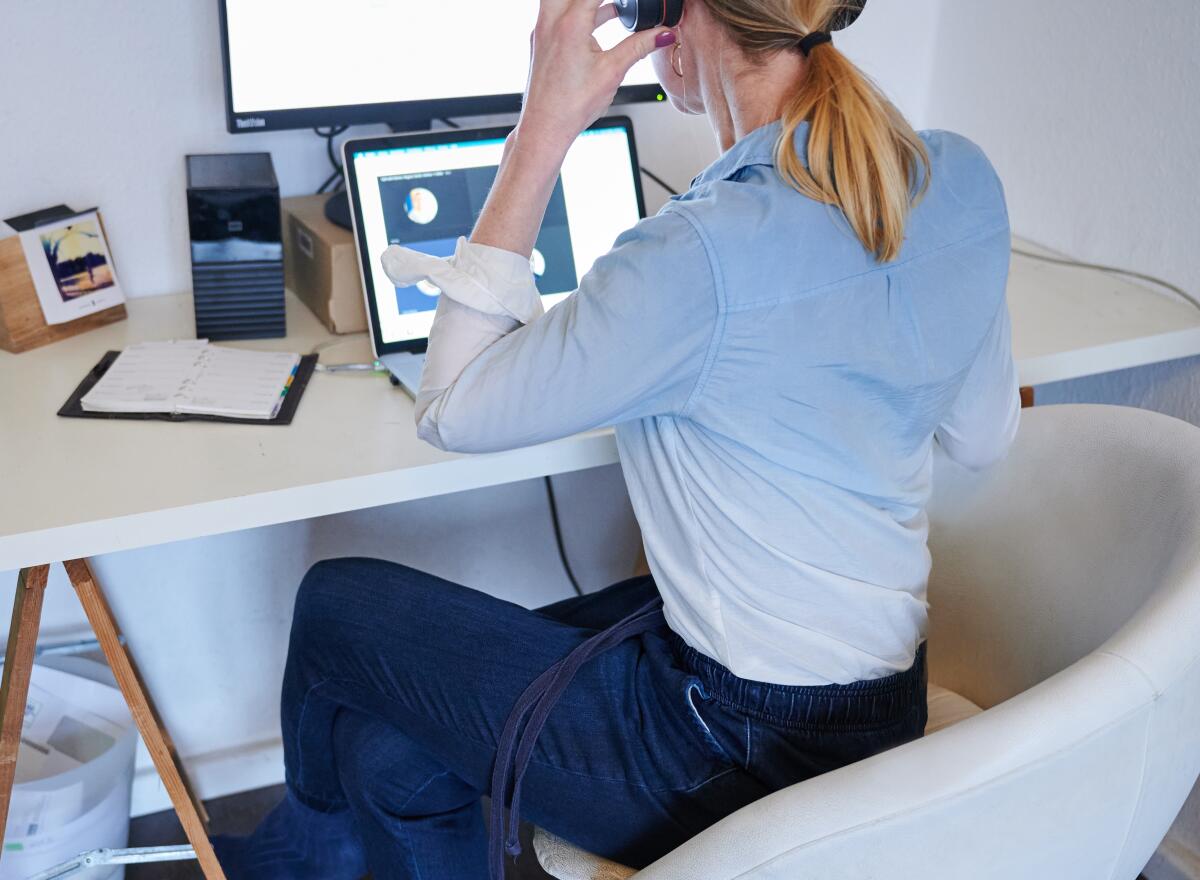Sitting down all day is killing us. The cure is surprisingly simple — and difficult

- Share via
From head to toe, our bodies are adapting to accommodate our devices. A majority of U.S. workers spend most of each weekday seated and looking at screens. We’ve thereby put ourselves in the midst of a slow-moving health crisis marked by alarming rates of early-onset diabetes and hypertension. Plus, by the end of most days — though it’s not the preferred medical terminology — we just feel like crap.
Many of us ignore our Apple Watches’ insistent, buzzing reminders to get up and move. Others work out before heading to our desks, mistakenly assuming an early-morning sweat makes up for the hours of sitting to come. And then there are the disciples of the standing desk, which unfortunately won’t fix our irregular blood sugar and lipid levels either.
After setting out to pinpoint the minimum amount of movement needed to offset the harms of our sedentary lives, Columbia University Medical Center researchers found that five minutes of gentle walking every half an hour does the trick. That’s easy to do if you’re in a controlled study in a Columbia exercise lab, where a clinician taps you on the shoulder every 30 minutes and leads you away from your laptop to a treadmill set to 2 mph. But what about in the real world? Is it possible to add regular movement breaks to our deadline-filled days? Sure, we might be able to tolerate the exercise, but what about the interruptions?
Experts say 20% of work will still be done from home post-pandemic — a shift that could benefit workers and their employers.
That’s what we tried to find out over three weeks this fall with an unusual project: We asked National Public Radio listeners to join a study run by the same Columbia researchers to see whether they could incorporate regular movement breaks or “snacks” into their day and report back on why they could … or couldn’t. More than 20,000 people signed up (nearly crashing the system). Here’s what we found out:
Movement breaks improved mental health too. Participants were in a better mood on days when they took movement breaks, reporting more positive emotions and fewer negative feelings. They also felt more energized, reporting an average 25% reduction in fatigue.
The breaks didn’t hurt job performance. Participants reported that they felt more engaged in their work and showed slight improvements in work quantity and quality on days when they took movement breaks.
But making time for frequent breaks is hard. Many participants struggled to take movement breaks from their daily routines every half an hour. Only 50% reported being able to take movement breaks that often. The commonly cited barriers were pressure to be productive at work, feeling too busy to take a break and concerns about disrupting workplace cultural norms.
Legislation on the subject has been considered in California and Congress. Companies across the country and world have made it a successful reality.
Participants found that taking movement breaks every hour or two was more realistic and less disruptive to their daily lives, with 70% to 80% of participants reporting taking regular breaks at these intervals. However, feeling too busy and work performance pressures were still regularly reported as barriers even to these less frequent breaks.
Our findings show that public interest and participation in research are critical to identifying the barriers to movement breaks and developing real-world solutions. But we hope this project also fast-tracks a broader conversation about a cultural reset, one that would require collective effort. We shouldn’t accept sacrificing our general mental and physical well-being just because society has come to regard constant sitting as the norm.
Now that everyone knows sitting too much is bad, what if it were acceptable to stand up in the midst of an endless Zoom meeting and shuffle side to side? Instead of admonishing kids about their screen time, what if we asked them whether they got their “stroll time” each day?
We used to accommodate smoke breaks, and these days few of us bat an eye if someone in a meeting looks at their phone. Behaviors, good and bad, are often contagious, but we need workplaces and schools to be willing collaborators in making time and space for movement. Our institutions need to encourage anyone who wants to change their relationship with their chair and devices.
The World Health Organization estimates that if we stay this sedentary, nearly 500 million people will develop heart disease, obesity, diabetes or other noncommunicable diseases this decade, costing governments $27 billion annually. Just as important, we’ll be condoning the disembodied way so many of us are living right now, denying the next generation the simple joys of feeling strong, healthy and mobile.
Manoush Zomorodi is the host of NPR’s “TED Radio Hour,” the creator of its “Body Electric” series and the author of “Bored and Brilliant: How Spacing Out Can Unlock Your Most Productive and Creative Self.” Keith Diaz is a certified exercise physiologist, an associate professor of behavioral medicine at Columbia University Medical Center and the director of the Exercise Testing Laboratory at Columbia’s Center for Behavioral Cardiovascular Health.
More to Read
A cure for the common opinion
Get thought-provoking perspectives with our weekly newsletter.
You may occasionally receive promotional content from the Los Angeles Times.











